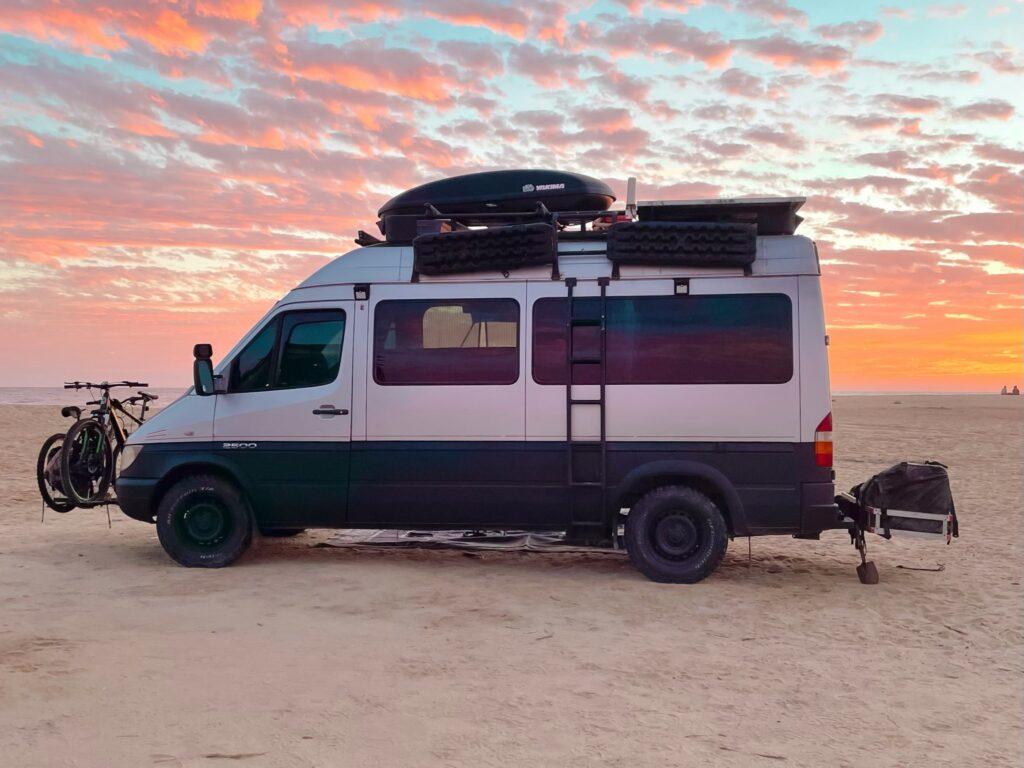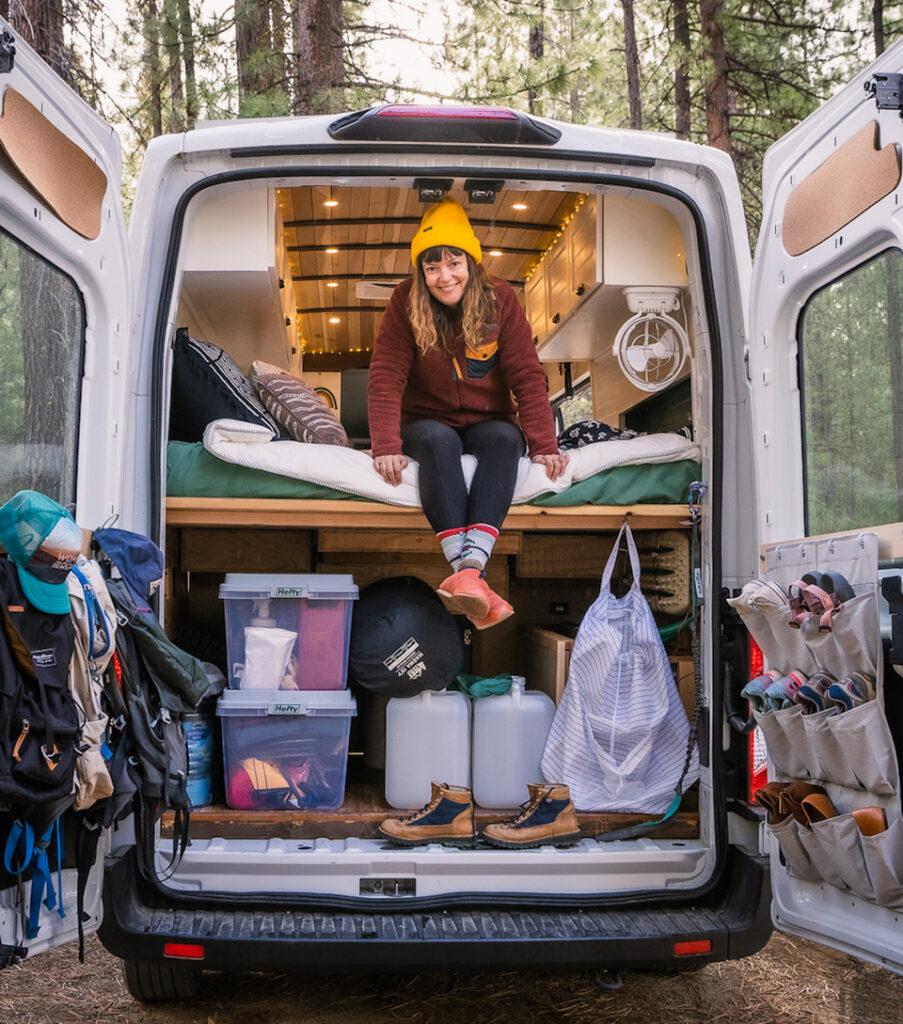By Dustin Grinnell
Social media doesn’t always depict a realistic view of what it’s like to live and work full-time in a van or RV. What’s the reality? It’s hard living, van lifers told us, but so worth it.
Feeling Like They’re Living Someone Else’s Life
When Noami and Dustin Grevemberg first met, they were living in New Orleans, working 9-to-5 jobs, feeling unfulfilled, like they were living someone else’s life.
“We met at a college football game and bonded over our love of travel and the outdoors,” says Noami. “I shared the idea of travelling the United States in a van and visiting all the national parks.”
An immigrant from Trinidad, Noami grew up watching documentaries about America’s national parks, like Yellowstone and Glacier. At the football game, she told Dustin she’d made a promise to visit as many parks as she could when she came to the country.
They started dating. Every chance they got, they’d escape New Orleans for the mountains, often travelling to Georgia to hike parts of the Appalachian Trail (AT). It was on the AT, during a multi-day hike in northern Georgia, when Dustin proposed to Noami.



Not long after, they both decided independently on the same day that they were going to buy a van and travel the country in it. “We came home from work and nervously told each other, ‘I have something to tell you,’” says Dustin. “‘No, I have something to tell you.’ ‘You go first.’ ‘No, you go first.” “‘Remember when we talked about seeing the national parks in a van? Why don’t we do that.’” And they did.
It was February 2016. They wanted to be on the road in the spring, so they gave themselves three months. They knew if they waited too long, they might talk themselves out of it. They searched online and found the van of their dreams, a Volkswagen Westfalia in Mobile, Alabama. They bought it on the spot, naming it Irie. A month later, they embarked on a road trip to Alaska to see the Aurora Borealis.
“Our one-year road trip turned into full-time van life, and eventually, we built a brand around Irie to Aurora and turned it into a business,” says Dustin.

Noami Grevemberg is also the founder of the Diversify Vanlife movement. Pick up her book, Living the Van Life, to discover what it’s really like to live and work full-time on the road in a camper van.
Van Life Opens You Up to The Elements
Living in a vehicle makes you more vulnerable to the elements. Most van lifers say they constantly have to adapt to changing weather conditions—rain, snow, wind, or sand.
In 2019, Natalie Rodriquez quit her job as a chef and bought a van with her wife and photographer, Abigail Rodriquez. The two have been driving across the country for three years, “finding freedom in simple living,” their website says.
One night, Natalie was on her van’s rooftop deck watching fireflies and heat lightning when a powerful storm rolled in. Abi was asleep inside, so Natalie raced to get the awning down and put the chairs in the van as rain and lightning crashed around her.
“We’ve been in crazy windstorms with hail and snow that came out of nowhere,” says Abigail. “But that’s what you have to deal with if you’re living in a van. All of it challenges you, but that’s also what’s so exciting for us.”



Dustin and Noami chase the ideal climate—75 degrees and sunny—but it’s not always easy to find it and they often deal with rain, snow, and desert climates. “Our life is in the elements,” says Dustin. “It can be dirty, muddy, wet, cold, or hot. When it rains, when it’s muddy or dusty, everything gets dirty.” But these van lifers love being in extreme environments. “It’s where the fun is,” says Dustin.
That’s why the couple only owns gear that can take a beating. “If the van breaks down and they have to do maintenance, it’s rarely in a convenient location,” says Noami. “The conditions are usually extreme. Our first major breakdown, we blew a head gasket in Oregon and had to disassemble the engine and put it back together in blizzard conditions.”
When Eric and Beth first met, they shared their interests in alternative living, the outdoors, and having more freedom. They were smitten. On their first date, they visited a dealership to look at vans. They married four months after meeting and then embarked on a series of “crazy” adventures. Shortly after, they started Adventure Van Camp, building custom vans in a garage in the woods in Vancouver, WA.
You’ll find the married couple working on vans and RVs no matter the conditions. They’ll wheel vans outside and build rain or shine, sometimes in 30-degree Fahrenheit weather. Their shop isn’t insulated, so when temperatures drop they bundle up in layers.
No big deal, according to Eric. “Before I started building vans, I worked in construction and home remodelling. I was always covered in sawdust. You just roll with it.”
Van Lifers Embrace a Do-It-Yourself Mentality



Talk to anyone living in a van and it becomes abundantly clear that if you decide to live in your vehicle, you’d better be willing to get your hands dirty because mechanics aren’t always right around the corner. Have a problem? Do it yourself (DIY).
Many van lifers who build out their vans from scratch, or do renovations or repairs themselves, figure things out through trial and error. When they need to learn how to do something, many turn to YouTube videos or YouTube University.
Since Abigail and Natalie bought their van, they’ve learned the basics of carpentry, plumbing, and electricity all on their own, often by watching videos. They’re always engaged in a project, whether it’s finishing a door, doing creative woodburning into logs, or building the interior of their van with reclaimed wood to make it feel homey. Natalie had wanted to build a rooftop deck for years. “My cousin came into town and we just banged it out in about nine hours,” she says. “I was like, ‘we’re doing it.’”
In 2020, Natasha Van Horne, an EMT from California, hit the road in her Ford Econoline E-350 while attending school remotely. She created a schematic for her van’s electricity and asked a friend who knew electrical systems to check her work. Then, with no prior experience, Natasha installed a battery, lights, a fan, and solar panels.
After buying her van, Emily Blanchard thought there was too much piping for the water to move through—and it leaked. So, she went to The Home Depot, bought new piping, and built a new system.


Solve one problem, and another emerges, Emily admits. “I was in the middle of nowhere in New Mexico when I turned on a light and everything short-circuited. I had no cell phone service, so I checked my fuse boxes and did some rewiring myself. I just had to figure it out on my own.”
Van life requires constant improvisation. Emily was in the Petrified Forest National Park when she heard a “terrible clanging sound.” She stopped and saw that her van’s solar panels were dangling from the van’s roof rack. She needed a certain type of screw but didn’t have them and the nearest Home Depot was two hours away. She used tape and zip ties to keep the panels in place, and they stayed put until she got back to civilization.
Van lifers Dustin and Noami are always making upgrades. Their van was built in Germany in 1985. It had most of what they needed for life on the road—a bench seat that folds out into a bed, a tiny kitchen with a sink, a propane stove, and plenty of storage—but they’ve made a lot of additions, like adding solar panels and expanding storage space.
“Our van is 35-years-old, so things break a lot, especially if we take it down bumpy roads,” says Noami. “We’re always fixing things, and I’ve replaced or upgraded almost everything—the cooling system, transmission, suspension, even the engine.” For folks who don’t have the time or interest to work on their vans, companies like Adventure Van Camp do custom builds. “We take what our clients are envisioning and make it into a reality,” says Beth. “It goes from an empty cargo van, and it rolls out as one of our little, tiny, homey, cozy, home-on-wheels.”
Van Life Is Hard Living – But It’s Worth It
For all the challenges that come with living in a van or RV, the alternative lifestyle remains a desirable lifestyle for many van lifers. Some folks think rent prices are too high or don’t have enough for a house. Others can’t stand to work in an office building. Some just want a steady stream of new experiences and to explore all the country has to offer.
Being mobile has allowed Chris and Taylor of Adventure Allens to go places they never thought they’d visit. One of the couple’s favourite places is Baja, Mexico, where they say the beaches are van life-friendly.
Five years ago, the couple was living on a houseboat in San Diego when they moved into a Sprinter van because they felt it would give them more freedom. “Van life allows us to just be free and do what we want without too much responsibility,” says Taylor. “We love waking up to different views all the time.”



Living in a van turns everyone into problem solvers and that can be deeply empowering. When a problem arises, Google isn’t always available, so you have to use your brain and whatever you have on hand to solve the issue. Unexpected challenges have turned many regular folks into electricians, plumbers, and carpenters.
“We had zero building experience before we moved into our van,” says Abigail. “But it inspired us to learn new skills and trades and work with power tools and make new things and cool designs. This has been an awesome, empowering experience for us.”
Brooke Weeber was full of doubts when she bought her van, but she learned the skills she needed to live in her van little by little, making mistakes along the way. “There were lots of tears, but I made it through,” she says. “It’s been really cool to learn a whole new set of skills, like woodworking and making repairs and renovations.”
Emily lives in Colorado, but she grew up in Massachusetts, where winters are dark and cold. She’s driven her van all over the country, from Florida, where it’s humid and buggy, to the hot Texas desert, where temperatures can climb to 115 degrees Fahrenheit.
“You have to be a chameleon and figure things out wherever you are,” says Emily. Whether I’m using my moon shade to block out the sun when it gets hot in the desert or using zip ties to hold down gear when it’s windy, I just jerry-rig things.”
“When I was a kid, I was always in my dad’s shop, doing things with my hands and getting dirty,” says Eric. “Van life allows me to work with my hands every day and build things that are tangible, not digital.”
Brooke bought her van because it allowed her to be closer to nature. She lived in New York City for years but came back to Portland, Oregon, where she grew up. “It’s refreshing to be surrounded by trees, dirt, and moss, not buildings and concrete. I love waking up in Nature and breathing it all in. It calms me.”



For van lifers the Allens, being in nature can spark awe. These van lifers love listening to the sounds of wind blowing through leaves, waves crashing, birds chirping. “We were in the high deserts of Arizona, parked next to trees as tall as towers,” says Chris. “Listening to the lightning strike at 7,000 feet, I realized how small human beings are.”
Van life is also about meeting new people and building community with folks who have similar worldviews and philosophies on life. Living in a van has allowed Eric and Beth to achieve a sense of belonging with clients and staff who are with their company. “My favourite part of the work has been building our own tiny community,” says Beth.
Van life has allowed Natasha to live out her vision of parenthood. She grew up travelling the country with her parents and wanted to do the same with her daughter, whom she co-parents. Her daughter was three when she bought a van and started renovating it.
“I love living in a van with my daughter, travelling the world and giving her these amazing experiences,” says Natasha. “I was homeschooled by my parents. We spent so much time in nature, hiking and camping, and we travelled all over the country. I wanted to give my daughter similar experiences I had when I was a kid.”
Natasha also wants to be a role model for other single moms. Whatever the circumstances, you can achieve your dreams. She urges single parents to take their kids outdoors and go backpacking and camping. And don’t be afraid to live in a van.
Van Life Provides Time for Self-Reflection and Self-Discovery



The year 2020 was devastating for Emily. Her mom passed away unexpectedly, she was laid off because of the pandemic, and her long-term boyfriend broke up with her via text message. She felt lost. She sold her possessions, bought a van, rescued a dog, and hit the road on a “healing, finding-myself journey.”
“Everyone says they’ll travel in retirement, but I wanted to have adventures when I’m young,” says Emily. “I’m not always the healthiest person,” she jokes. “I eat a lot of fast food. I’m not promised tomorrow; I want to see the world before I get too old.”
Living in a van has given Emily many new life experiences. She loves hiking in beautiful places. The best thing about van life? How much she’s learned about herself. When she’s in nature, she feels more grounded with who she is.
Van life leads to self-discovery for many folks, but it also teaches most about other people and the world we all inhabit. Emily is often asked if she feels safe or if she’s ever scared when she’s out on the road.
“Living in a van has taught me that the world isn’t as mean as everyone thinks it is,” she says. “There’s nothing more peaceful than being in the middle of nowhere in your van by yourself. It’s actually the most amazing, beautiful experience there is.”
Dustin Grinnell is an essayist and fiction writer based in Winthrop, Massachusetts. His creative nonfiction has appeared in many popular and literary publications, including The Boston Globe, New Scientist, VICE, Salon, and Writer’s Digest. He has an MFA in creative writing from the Solstice MFA Program and an MS in physiology from Penn State. Learn more at dustingrinnell.com.



